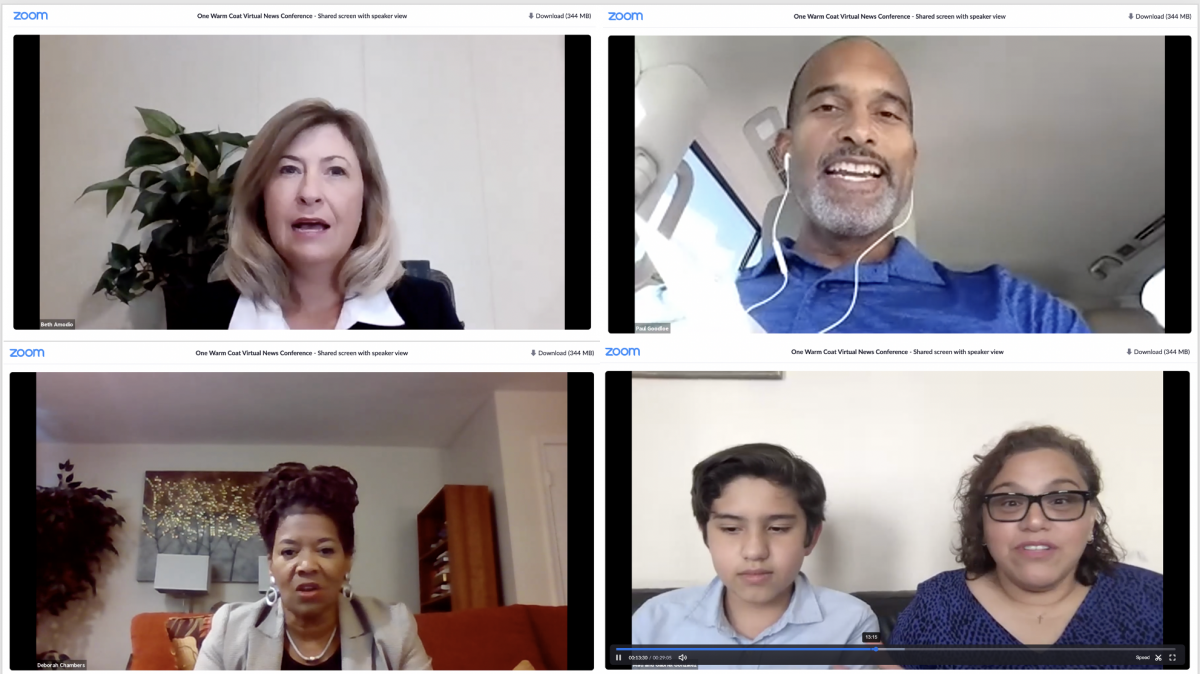
The nonprofit One Warm Coat used a virtual news conference to kick off its annual winter coat drive campaign.
Nonprofit communicators are preparing for a year-end giving season unlike any other.
But while Covid-19 will make it downright impossible to host in-person fundraising events and quite difficult to bring members of the media onsite for site visits and interviews, it also creates some new opportunities.
For example, we’ve discovered that Zoom and other virtual meeting tools make it much easier for resource-strapped nonprofits to gather the media for briefings and news conferences.
Throughout the pandemic, we’ve staged a number of virtual news conferences and have found the format offers nonprofits an easy, accessible way to share important announcements and information with the media. As the year-end giving season looms, nonprofits have an opportunity to generate media coverage by holding virtual briefings with the media to discuss the extraordinary need for donations and offer advice on how to give wisely during the holiday season.
They can also help position your leaders and board members as expert sources.
Advantages of Virtual News Conferences
Virtual news conferences offer several clear advantages over traditional, in-person events. These advantages include:
Logistics — On-site press conferences have always been labor-intensive, with the need to find the right location and proper supporting visuals. Often, these are outdoor affairs, so you also have to contend with the potential for rough weather.
Conversely, the logistics for a Zoom news conference are simple. You simply set up the meeting through your Zoom account, and send the log-on link and call-in info as part of an alert to your media list.
Media members, meanwhile, don’t have to worry about traveling to the event, setting up cameras and microphones, and navigating around each other.
Increased media participation — Because the logistics are simple, virtual news conferences can be well attended by the media — provided, of course, that you’re offering them something newsworthy.
Local TV stations, for instance, don’t even have to worry about sending a reporter to record a live stand up. They can simply have a producer record the session and grab a video sound bite and the reporter can add his or her piece later.
Virtual news conferences also make it easier to attract out-of-town media. We recently coordinated a virtual news conference to announce an important new development in an effort to secure state funding for a community college in Erie, Pa. Because it was hosted online, we were able to get a reporter from the state capital in Harrisburg (located nearly five hours away) to log onto the conference and cover the announcement. That is something that would have been all but impossible at an in-person news conference.
Easier, more substantial follow-up — You can also make the news conference available to journalists who are unable to attend. Simply hit ‘record’ at the start of the press conference, and, voila, you have he complete session video-recorded and ready to share. Reporters can go back later, watch the recording, and grab the quotes and sound bites they need on their own time.
How to Stage a Successful Virtual Event
Like all virtual events, online news conferences have a different feel than their in-person counterparts.
As a result, it’s important to spend time up front working through the logistics and making sure you come across as professional and prepared. Here are a few tips:
Keep it short — With a virtual news conference, you’re promising convenience. Avoid abusing that promise by wasting their time with a long presentation. Keep the prepared remarks relatively brief (no more than 15-20 minutes) and make sure you’re focusing on what’s going to be of interest to a reporter covering the story. This isn’t a commercial about your organization but rather an opportunity to share important news and insights.
Include multiple voices — Most news reports rely on multiple sources to give them color and credibility. As a result, it’s helpful to try to include multiple speakers who are available to provide insights and answer questions. Recently, we worked with the nonprofit One Warm Coat to host a virtual news conference that explained the dangers of the upcoming winter season and the incredible need for warm coats during Covid-19. To tell the story, the nonprofit’s CEO was joined by the leader of a nonprofit in Washington, D.C., that provides services to those in need, a mother and son who lead coat drives, and a winter weather expert from the Weather Channel.
Develop a clear run-of-show — If you are having multiple speakers, make sure you give them clear instructions on who is speaking when and key talking points. It’s also important to designate someone was the emcee who can introduce all of the speakers and monitor questions at the end.
Nail the logistics — Make sure you spend ample preparing the visual presentation. You want to make sure all of your spokespeople look good on camera. You should also schedule a run through before you go live – mostly to ensure everyone is properly lit and positioned at an ideal distance from their screen. This will also allow you to make sure all of your speakers understand the run of show and how you’ll moderate questions.
Remind participants that everything is being captured on video — After months of living our professional lives on Zoom, most of us are familiar with the idea that the camera is always rolling. But because this is being broadcast to the media — and because they’re potentially using the video in their reporting — you’ll want to make sure that people remember to stay focused and alert (and avoid stepping away or picking their noses).
Finally, remember that your virtual event promises something that will actually be useful to the media. We recommend organizing these events to provide practical advice that will resonate with audiences or to discuss a unique or pressing challenge.
You might even consider partnering with other nonprofit organizations to help cover multiple angles.
With the right hook and enough preparation, a virtual news conference can help your organization share its message and gain media coverage — even during this challenging time.






